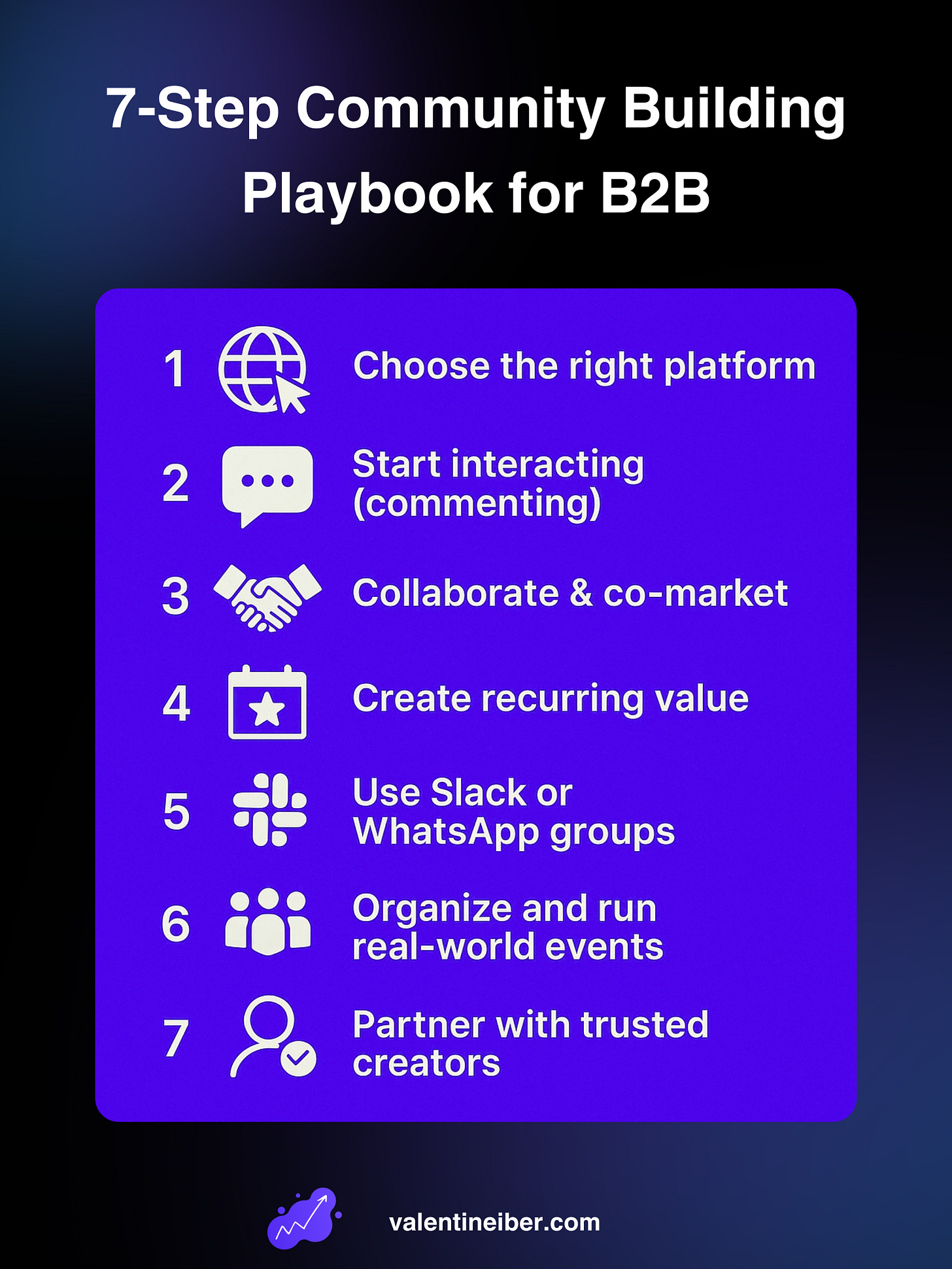🧠 Underrated B2B Growth Tactic: Community Building
(and how to use it for your startup)
Companies tend to overlook this cost-effective tactic when planning their Go-To-Market strategy.
Here’s a 7-step playbook to tap into community as a sustainable growth engine:
1️⃣ Choose the right platform or medium
Before you can choose a platform, you need to understand where your target audience is.
Important: Don't make assumptions and don't assume.
Better: Conduct short interviews (10 minutes is usually enough) with your target group. Be authentic, don't sell anything and have fun with the conversation. Once you have conducted 5 interviews per persona (for each ideal customer), you should have enough information to select the platforms.
Pick 1–2 platforms where your ideal customers already hang out — and commit. Some examples:
LinkedIn → B2B, B2G, B2C, D2C,… nearly everyone ;)
Twitter / X → Tech, startups, solopreneurs, Gov
Slack / Discord → Micro-communities, niche power networking, tech/dev, Crypto
Youtube → For deep dives & niche topics
TikTok → (Micro-)communities
Product Hunt → Tools & Tech
You don’t need to build a community (yet). Just start showing up where your people already are.
Examples:
✅ Notion → Engaged early on Twitter, Reddit and Slack groups where their core users lived.
✅ Figma → Participated in design-focused Slack spaces like Designer Hangout to connect with designers before launching their own channels.
2️⃣ Start interacting (commenting)
Commenting is content — and it’s your shortcut to visibility.
Follow 10–15 people your audience already follows
Spend 10 minutes/day leaving thoughtful, relevant comments
Don’t just agree — add value or ask a smart question
Do this consistently, and people will start recognizing your name.
Examples:
✅ PostHog → Founders actively participated in open source and indie hacker forums.
✅ Arc Browser → Built presence through highly contextual Twitter replies to early adopters and creators.
3️⃣ Collaborate & co-market
You don’t need to buy reach if others create it for you for free.
Co-create content with other people or companies who have the same target audience.
Try:
Joining podcasts, shows or events as a speaker
Co-creating lead magnets or carousels
Hosting Webinars, AMAs or Q&As
Cross-promotions in newsletters
Co-create YouTube videos or short form content
Examples:
✅ Loom → Co-marketed with productivity creators and YouTubers.
✅ Ahrefs → Collaborated with SEO influencers and even competitors to co-create content and backlinks.
4️⃣ Create recurring value
These are high-trust, recurring touchpoints that pull people deeper into your world.
Ideas:
Weekly post series (e.g. “YOUR TOPIC Thursdays”)
Lead magnets tied to trending topics
Monthly Zoom hangouts
A “building in public” or educational newsletter
Examples:
✅ Superhuman → Used personal founder updates to build anticipation and trust during their waitlist phase.
✅ Lenny’s Newsletter → Weekly insights evolved into a full community, podcast, paid membership, and ecosystem.
5️⃣ Utilize WhatsApp, Slack or Discord communities
Build spaces where users and customers can interact — and include you in the conversation.
Use these for:
Feature requests and product feedback
Peer-to-peer learning and best practice sharing
Identifying success story candidates or UGC opportunities
Examples:
✅ Scripe → Grew by enabling a WhatsApp community for creators and customers.
✅ Descript → Uses Discord and Slack to field feedback, share feature updates, and learn directly from users.
6️⃣ Organize and run offline events
Physical events are underrated — especially when they’re intimate, niche, and designed for learning and exchange.
Great formats:
Executive / founder dinners
Pre- or Side-events around larger fairs/conferences
Local meetups for niche groups
Invite-only product deep dives or beta tests
Examples:
✅ First Round Capital → Built a reputation for hosting small founder dinners with lasting impact.
✅ Pitch → Organized meetups with creators and startups in the design and storytelling space to boost adoption.
7️⃣ Partner with trusted creators
Once you have traction, try strategic partnerships with creators (aka influencers or thought leaders) your audience already follows.
A collaboration could look like this:
Special deals, e.g. via partner programs (affiliates)
Guest in your podcast or speaker in your webinar
Content co-creation
Product or service promotion
You don’t need a big budget — just the right voice and trust.
Examples:
✅ Linear → Partnered early with respected dev tool influencers and podcast hosts.
✅ Webflow → Supported creators in building tutorials, hosting workshops, and growing meetups.
Final Thought
Visibility → Trust → Recommendations → Pipeline.
Building a community is a longterm investment, and a great way to grow a business sustainable.
If you load it up with extra budget, you'll outperform any competitor who relies solely on standard marketing and paid growth.



